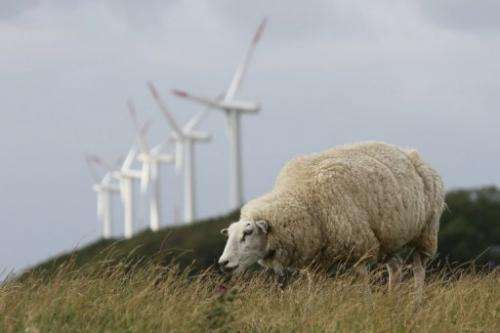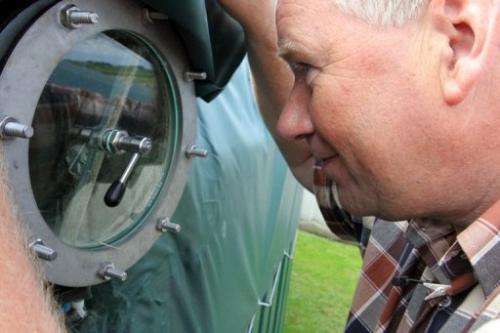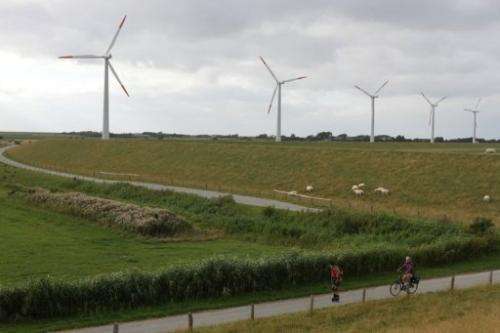Windswept German island gives power to the people

The clock may tick a little slower on the remote, windswept German island of Pellworm, but when it comes to renewable energy, it has long been ahead of its time.
Home to about 1,000 people and three times as many sheep, the sleepy North Sea outpost of reed-roofed homes, set amid vast tidal mudflats, has for decades been a pioneer in solar and wind power.
Long before Germany's 2011 post-Fukushima energy transition, it started to make its own clean energy—in fact about three times as much as it needs, allowing it to "export" the rest to the mainland.
And like a growing number of German communities, Pellworm has made sure the shift toward a zero-carbon future is driven not by big energy companies but by local people who earn a healthy profit in the process.
"It started in the early 1980s when different types of windmills and solar panels were tested here. Back then the technology was in its infancy," says island Mayor Juergen Feddersen.
"That's when we first became known as the renewable energy island."
At first glance, Pellworm does not look like a high-tech pioneer. The island has one police officer, one traffic light and one supermarket. Half a dozen prawn fishing boats line the picturesque harbour.
With a history of catastrophic floods, the islanders are well-sensitised to climate change and rising seas. At high tide Pellworm is two metres (seven feet) below the water level, protected only by dykes.
In centuries past, anyone who damaged the grass-covered sea defences faced the harshest punishment.
"They were buried in the dyke, dead or alive," says island historian Walter Fohrbeck.
Today the community deals with the threat of high seas in a more benign manner.
Thanks to a German law which guarantees citizen-producers premium prices for the clean energy they sell over 20 years, the people of Pellworm, like several hundred other German communities, have become "energy farmers".

Now the biggest structures on the island, aside from a lighthouse and a church dating from 1096, are eight 67-metre high windmills, set far from the tourist sites so as not to spoil the view.
"We are well aware of climate change, we live right on the sea and must recognise that ocean levels are rising," said Kai Edlefsen, 50, an organic cattle farmer who also runs the local windpark.
"We can't save the world alone, but we can do our part for a better climate tomorrow."
The windpark, owned by 40 local families, can power 400 households.
"We have realised the idea of the citizens' wind farm ... this has been key to gaining the acceptance of the local population," said Edlefsen, who is also deputy mayor.
Many homes and barns have also been fitted with south-facing photovoltaic panels on their roofs, also set up with government incentives.
To keep the lights on dark and windless days, a biogas plant turns shredded corn and manure into methane to make electricity. The surplus heat keeps the town hall and a clinic warm and cosy and heats a public swimming pool.
Fohrbeck said Pellworm thus saves 5,500 tonnes of CO2 a year—offsetting the greenhouse emissions of 500 people "on the mainland".
To further green the island, the local administration has subsidised energy-saving electric appliances and used heat-imaging cameras to help locals see where their homes are leaking warmth to improve insulation.
So far, Pellworm has exported the surplus electricity to the mainland, via an undersea cable which in turn also supplies Pellworm with backup power when needed.

A new research project aims to take the island one step further—to eventual all-day, everyday power self-sufficiency.
At the site of the island's solar-wind hybrid park, power company E.ON Hanse, together with a host of partners, has this week begun to trial various storage technologies and a so-called smart grid system.
There are shipping-container sized battery units—one using the lithium-ion technology known from mobile phones, the other the so-called Redox-Flow system.
The project also will equip 10 households with fridge-sized batteries that will be fed by their solar panels. In another 20 homes, electric heating units will double as power storage devices.
A future "smart grid" would intelligently balance supply and demand, turning on washing machines at optimum times and using electric car batteries as integrated storage devices.
In the long run, says Fohrbeck, the island wants to be not just "electricity-positive" but "energy-positive", by also phasing out the petrol used in cars and the oil in residential heating.
The island's growing reputation as a clean, green getaway is helping.
As more tourists arrive seeking climate-friendly holidays, a Hamburg investor this year set up shop on Pellworm. He offers four small Renault electric cars for rent, with which tourists can zip around the island.
© 2013 AFP


















